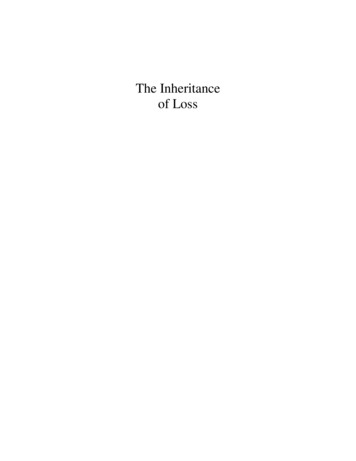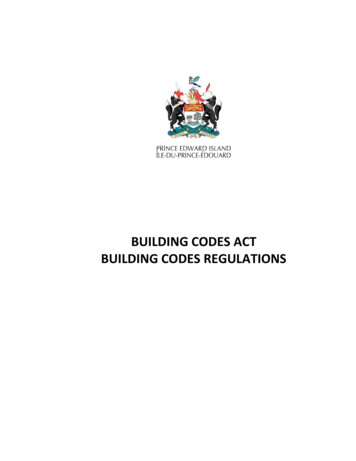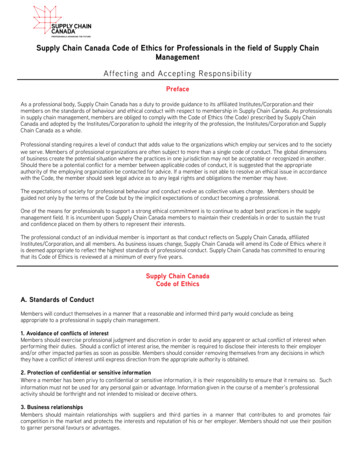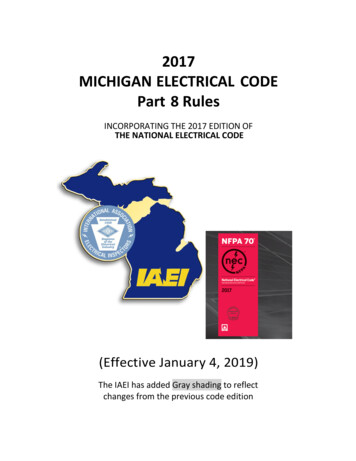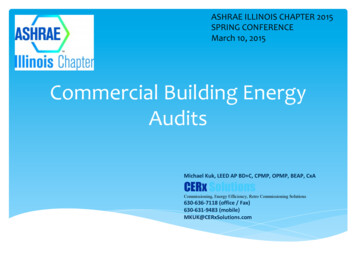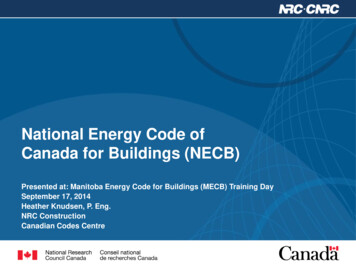
Transcription
National Energy Code ofCanada for Buildings (NECB)Presented at: Manitoba Energy Code for Buildings (MECB) Training DaySeptember 17, 2014Heather Knudsen, P. Eng.NRC ConstructionCanadian Codes Centre
Outline Canada’s Code Development SystemObjective-based codesHistory of energy code development in CanadaNECB 2011:‒‒‒‒‒approachapplicationcompliance pathsperformance levelsupporting documents and tools NECB 2011 Part 7: Electrical Power Systems and Motors2
Terminology MNECB: 1997 Model National Energy Code for Buildings NECB: 2011 National Energy Code for Buildings SCEEB: Standing Committee on Energy Efficiency inBuildings CCBFC/Commission: Canadian Commission on Buildingand Fire Codes PTPACC: Provincial/Territorial Policy Advisory Committeeon Codes3
Canada’s Code Development System 4National Building CodeNational Fire CodeNational Plumbing CodeNational Energy Code for Buildings
Canada’s Code Development System National model constructioncodes must be adopted byprovincial or territorial authoritiesto become law Manitoba adopted NECB withamendments on December 20,2013, with enforcement to beginDecember 1, 20145
Canada’s Code Development System6
Canada’s Code Development SystemThe CCBFC: promotes uniform adoption and understanding of theNational Model Construction Code Documents responds to the needs and priorities of the adoptingauthorities facilitates the resolution of issues related to the codedocuments establishes and implements policies, procedures andpriorities and advises NRC on the need for code-related research7
Canada’s Code Development SystemMembership of the CCBFC and its Standing Committeesreflects a matrix with: balanced representation from major sectors‒ regulatory‒ industry‒ general interest broad geographic representation8
Canada’s Code Development SystemFrom code change request to proposed change: Code change request from proponent CCC staff analysis Standing Committee review CCBFC input Standing Committee development Proposed Change (PCF)9
Canada’s Code Development SystemFrom proposed change (PCF) to requirement: Public review Standing committee final recommendation Commission decision Publication of codes10
Canada’s Code Development SystemCode Change Request anyone can request a code change SC reviews and decides to address or reject a request only minor tasks can be addressed without approval more complex issues are subject to approval by CCBFC major scope, cost or policy implications go to CCBFCProposed Change cost-benefit and enforcement implications are important there are rules for code requirements SCs address all public comments Final approval rests with the CCBFC11
NRC Construction Role Administrative and technical advisory support to CCBFCand PTPACC (Canadian Codes Centre) Research support to the development of national modelcodes (e.g. hygrothermal performance of buildings) Construction materials evaluation service for industry andregulatory authorities (Canadian Construction MaterialsCentre)12
Outline Canada’s Code Development SystemObjective-based codesHistory of energy code development in CanadaNECB e paths,performance level,supporting documents and tools NECB 2011 Part 7: Electrical Power Systems and Motors13
Objective-based CodesThree Divisions in each model code: Division A – Compliance, Objectives and FunctionalStatements Division B – Acceptable Solutions Division C – Administrative Provisions14
Objective-based Codes Spell out why building design and construction isregulated: “Objectives” in Division A Describe what the design and construction of the buildingmust do to achieve the objectives “FunctionalStatements” in Division A Provide “Acceptable Solutions” that meet theobjectives and functional statements in Division B Allow for “Alternative Solutions”, provided they meetthe same objectives and functional statements15
Objective-based codes – NECB ObjectiveOE EnvironmentAn objective of this Code is to limit the probability that, as a resultof the design or construction of the building, the environment will beaffected in an unacceptable manner.OE1 ResourcesAn objective of this Code is to limit the probability that, as a result of thedesign or construction of the building, resources will be used in a mannerthat will have an unacceptable effect on the environment. The risks ofunacceptable effect on the environment due to use of resources addressedin this Code are those caused by –OE1.1 excessive use of energy16
Objective-based Codes - ExampleSentence 4.2.1.3.(1) specifies the limits to installed interior lightingpower. These limits are considered to be acceptable solutions withregards to energy use.In an attribution table, the Sentence is linked to‒ Functional Statement F94:To limit the unnecessary demand and/or consumption of energy forlighting.‒ Objective OE 1.1:Environment – Resources – Limiting the probability of excessiveuse of energyAn alternative solution might entail a higher installed interior lightingpower than permitted but with provision of additional control of thatlighting (beyond existing control requirements).17
Objective-based CodesSupplement to NECB 2011 – Intent Statements Intent Statements explain in plain language the reasonfor a Code provision Use standard phrases "to limit the probability that/of “."which could lead to " Published electronically only Not code material18
Outline Canada’s Code Development SystemObjective-based codesHistory of energy code development in CanadaNECB e paths,performance level,supporting documents and tools NECB 2011 Part 7: Electrical Power Systems and Motors19
History of energy codes in Canada 1974 – Department of Energy, Mines and Resourcesrequested interdepartmental committee to draftguidelines for energy efficiency of government buildings Associate Committee on National Building Code(ACNBC) given mandate20
History of energy codes in Canada Standing Committee on Energy Conservation in Buildings– First meeting – November 1976– Code set as prescriptive– Code based on ASHRAE 90.1 Standard Fall 1977 – first draft document for public comment21
History of energy codes in Canada 1978 – First edition of “Measuresfor Energy Conservation in NewBuildings”22
History of energy codes in Canada Second edition of “Measures for Energy Conservationin Buildings” published in 1983– New section for houses– Quebec only province to adopt Measures, with somechanges– 1990 Ontario Building Code included insulation levels forhouses based on 1983 edition– CMHC – compliance mandatory for housing financed underNational Housing Act23
History of energy codes in CanadaModel National Energy Code for Buildings 1997 Prescriptive approach: building envelope, HVAC,service water heating, lighting, electrical power Engineering approach: “Performance Compliancefor Buildings”Model National Energy Code for Houses(MNECH) also published in 199724
History of energy codes in CanadaModel National Energy Code for Buildings 1997 Referenced in Ontario Building Code Used in voluntary and incentive programs– Commercial Buildings Incentive Program– Utility and other programs– LEED 25
History of energy codes in CanadaModel National Energy Code for Buildings 1997 Energy/economics code Requirements and exemptions based on– Principal energy source– “Administrative region” Climatic criteria Energy distributor26
History of energy codes in CanadaModel National Energy Code for Buildings 1997 No consistent performance level established throughthe different compliance paths– Prescriptive path and simple building envelope trade-off path Performance varied with fenestration-to-wall ratio– Computer-assisted building envelope trade-off pathand performance compliance path Performance varied with fenestration-to-wall ratio to 40%,capped at 40% for fenestration to wall ratios above 40%27
History of energy codes in Canada NRCan presentation and request to update MNECB 1997at June 2005 CCBFC meeting Motion“Moved and seconded that CCBFC supports, as a firstphase, the work on the technical basis for the developmentof the revisions to the MNECB as a progeny document oncondition that the necessary support and funding for theproject is provided from NRCan and/or others.”28
History of energy codes in Canada Building Energy Codes Collaborative (BECC)– Business plan– Provincial / territorial support– Funding from NRCan Plan to update MNECB 1997 presented and approved atFebruary 2007 CCBFC meeting29
History of energy codes in Canada Standing Committee on Energy Efficiency in Buildings(SCEEB) formed in 2007 First meeting in December 200730
Outline Canada’s Code Development SystemObjective-based codesHistory of energy code development in CanadaNECB e paths,performance level,supporting documents and tools NECB 2011 Part 7: Electrical Power Systems and Motors31
NECB approach Energy used by building energy source neutral Based on climaticzone – heatingdegree-days(HDD)32Average AnnualHeating-Degree Days(C-degrees)
NECB approach Silent on renewable, waste and site-generated energy– Wide variety of technology– Not place barriers for their use– Reference standards for use,not efficiency33
NECB approach Silent on most process loads– Except pools and ice surfaces– Performance path includes: Guidance Flexibility34
NECB approach No differentiation based on occupancy Same structure as MNECB––––––35Part 3: Building EnvelopePart 4: LightingPart 5: Heating, Ventilating and Air-Conditioning SystemsPart 6: Service Water Heating SystemsPart 7: Electrical Power Systems and MotorsPart 8: Performance Path
NECB application New buildings (as defined inNBC; “Part 3 buildings”) Additions Does not apply tomajor renovations,farm buildings36
NECB compliance paths Prescriptive path Building envelope trade-off paths– Simple– Detailed Lighting, HVAC and service water trade-off paths Performance compliance path– Whole-building modeling / engineering solution37
NECB compliance paths38
NECB compliance paths Mix and match simpleprescriptive andtrade-off paths Use trade-off withinsame Part only39
NECB compliance paths Cannot mix any otherpath with performancecompliance path(whole buildingapproach)40
NECB performance level Consistent minimum acceptable performance levelfor all compliance paths Established based on minimum prescriptive pathrequirements41
NECB vs MNECB performance levels42
NECB performance results35%26.2% Large Secondary Mid-Rise Warehouse Big BoxOfficeSchool ApartmentStoreStrip Mall
NECB performance resultsPerformance Improvement over MNECB by City44
NECB 2011 supporting documents and tools Supplement to the NECB 2011: Intents Statements User’s Guide to the NECB 2011 *new* Trade-off Path Tools *coming soon*‒ Lighting trade-off path‒ HVAC and SWH trade-off paths NECB 2011 Compliance Checklists Adaptation Guidelines for the NECB 2011 Online presentations on each Part Energy modeling software with NECB 2011 referencebuilding: CAN-QUEST45
Outline Canada’s Code Development SystemObjective-based codesHistory of energy code development in CanadaNECB e paths,performance level,supporting documents and tools NECB 2011 Part 7: Electrical Power Systems and Motors46
NECB 2011 Part 7: Electrical Power Systemsand Motors Part 7 applies to electrical power systems and motorsconnected to the building’s electrical service47
NECB 2011 Part 7: Electrical Power Systemsand Motors Prescriptive requirements‒‒‒‒Electrical distribution systemVoltage drop - feeder conductors and branch circuitsTransformersElectrical motors There is no trade-off path in Part 748
NECB 2011 Part 7: Electrical Power Systemsand Motors Prescriptive requirements‒‒‒‒Electrical distribution systemVoltage drop - feeder conductors and branch circuitsTransformersElectrical motors There is no trade-off path in Part 749
NECB 2011 Part 7: Electrical Power Systemsand Motors Prescriptive requirements‒‒‒‒Electrical distribution systemVoltage drop - feeder conductors and branch circuitsTransformersElectrical motors There is no trade-off path in Part 750
Questions?www.nationalcodes.nrc.gc.caThank you
National Energy Code of Canada for Buildings (NECB) . Manitoba Energy Code for Buildings (MECB) Training Day September 17, 2014 . Heather Knudsen, P. Eng. NRC Construction . Canadian Codes Centre . ‒performance level ‒supporting documents and tools NECB 2011 Part 7: Electrical Power Systems and Motors 2 . Terminology MNECB: 1997 .


